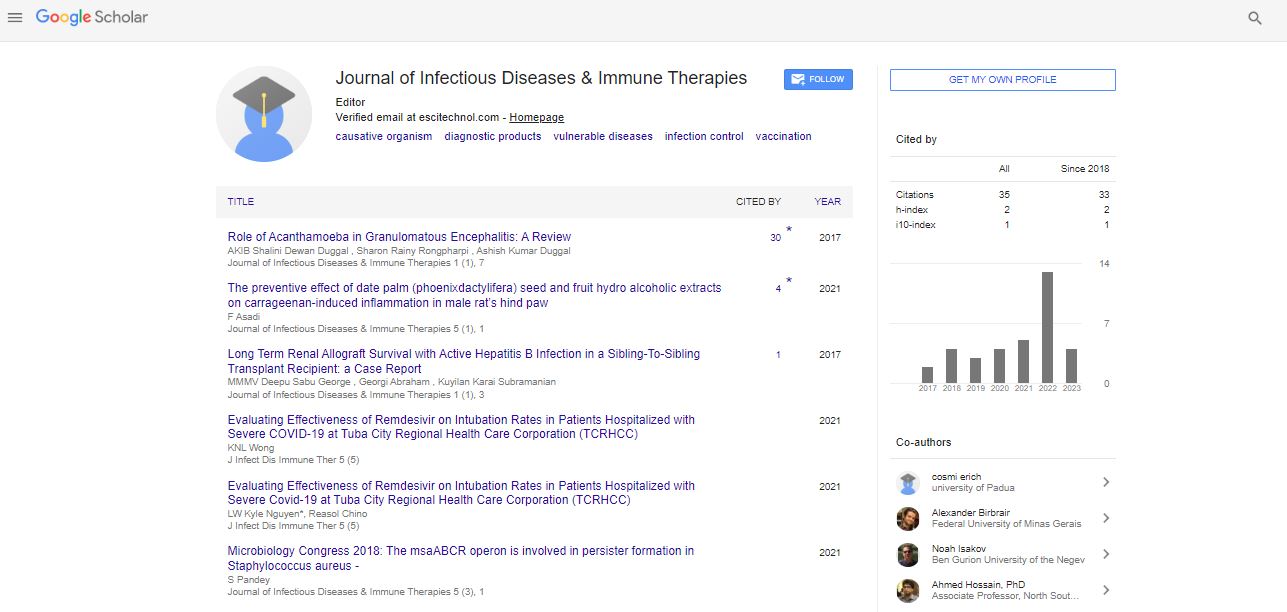Perspective, J Aging Geriatr Med Vol: 7 Issue: 3
Viral Hepatitis Variants and Their Clinical Implications
Zinvu Lee*
1Department of Clinical Laboratory, Nanjing Medical University, Suzhou, China
*Corresponding Author: Zinvu Lee,
Department of Clinical Laboratory, Nanjing
Medical University, Suzho, China
E-mail: leezinvu@163.com
Received date: 28 August, 2023, Manuscript No. JIDITH-23-117457;
Editor assigned date: 30 August, 2023, PreQC No. JIDITH-23-117457 (PQ);
Reviewed date: 13 September, 2023, QC No. JIDITH-23-117457;
Revised date: 21 September, 2023, Manuscript No. JIDITH-23-117457 (R);
Published date: 29 September, 2023, DOI: 10.4172/2329-9541.1000349
Citation: Lee Z (2023) Viral Hepatitis Variants and their Clinical Implications. J Infect Dis Immune Ther 7:3.
Description
Hepatitis, a term describing inflammation of the liver, is a global health issue that affects millions of people worldwide. It is a silent epidemic, often undiagnosed until complications arise. The causes of hepatitis vary depending on the type. Viral infections are the most common, but hepatitis can also result from alcohol abuse, autoimmune diseases, and certain medications. Symptoms of hepatitis can range from mild to severe and may include fatigue, jaundice (yellowing of the skin and eyes), abdominal pain, and nausea. Many cases of hepatitis go undiagnosed because the symptoms are often mistaken for other illnesses. Hepatitis is a significant global health concern. It can lead to severe complications such as liver cirrhosis and liver cancer. The economic burden of hepatitis, due to healthcare costs and loss of productivity, is substantial. Viral hepatitis is a major public health concern with significant economic and healthcare implications. People of all ages, races, and socioeconomic backgrounds are affected by it. Ongoing efforts in public health are directed towards raising awareness, improving access to vaccination, promoting safe practices, and conducting surveillance to detect and manage outbreaks.
Types of hepatitis virus
Hepatitis A: The Hepatitis A Virus (HAV), a tiny single-stranded RNA virus, is what causes hepatitis A. It can also be contracted by direct person-to-person contact but is typically spread through the intake of tainted food or drink. Fatigue, jaundice (yellowing of the skin and eyes), abdominal discomfort, nausea, vomiting, dark urine, and pale feces are among the signs and symptoms of hepatitis A. However, some people, especially kids, might not exhibit any symptoms. The best way to avoid Hepatitis A is through vaccination. Aside from handwashing, consuming clean food and water, good hygiene practices are vital for lowering the risk of infection.
Hepatitis B: The Hepatitis B Virus (HBV), a virus with a portion of double-stranded DNA, is what causes hepatitis B. Contact with contaminated blood, semen, or other bodily fluids is the main way that HIV is spread. It can result in liver cancer, cirrhosis, and chronic hepatitis. Hepatitis B symptoms, which include fatigue, jaundice, abdominal discomfort, nausea, and black urine, can be mild to severe. Early diagnosis of chronic hepatitis B is essential because it may not exhibit any symptoms. Hepatitis B is primarily prevented via vaccination. Important preventive methods include using sterile needles, screening for pregnancy, and safe sexual behaviors.
Hepatitis C: Hepatitis C is an RNA virus caused by the Hepatitis C Virus (HCV), It is mainly transmitted through blood-to-blood contact, often through the sharing of needles among drug users. Hepatitis C can lead to chronic liver disease and is a leading indication for liver transplantation. Many people with Hepatitis C may remain asymptomatic for years. Symptoms, when present, can include fatigue, jaundice, and abdominal discomfort. There is no vaccine for Hepatitis C, so prevention relies on harm reduction strategies, including the use of clean needles for injections and avoiding risky behaviors that may expose individuals to infected blood.
Hepatitis D: Hepatitis D, also known as delta hepatitis, is caused by the Hepatitis D Virus (HDV). It is unique in that it can only occur in individuals who are already infected with Hepatitis B. HDV worsens the outcome of HBV infection. The symptoms of Hepatitis D can be severe and may include more rapid progression to cirrhosis and liver failure compared to HBV infection alone. Hepatitis B vaccination not only protects against HBV but also indirectly prevents Hepatitis D, as HDV requires HBV as a co-infection.
Hepatitis E: Hepatitis E is caused by the Hepatitis E Virus (HEV), an RNA virus. It is usually transmitted through the consumption of contaminated water and food and is most common in areas with inadequate sanitation. Hepatitis E often presents with acute symptoms similar to Hepatitis A, including fatigue, jaundice, abdominal pain, and nausea. However, it can be particularly severe in pregnant women, leading to high mortality rates. Prevention of Hepatitis E includes ensuring access to safe drinking water and sanitary conditions. No specific vaccine is widely available, though some have been developed and used in specific regions.
Conclusion
Viral hepatitis encompasses a spectrum of diseases caused by different viruses, each with its own characteristics and modes of transmission. Understanding the various types of hepatitis, their causes, symptoms, and preventive measures is essential in the fight against these infections. With the advent of effective vaccines for Hepatitis A and B, significant progress has been made in preventing these diseases. However, Hepatitis C remains a challenge, and studies is ongoing to develop new therapies and expand preventive strategies. By combining vaccination, safe practices, and increased awareness, one can reduce the impact of viral hepatitis on individuals and communities worldwide and move closer to the goal of eliminating this silent epidemic.
 Spanish
Spanish  Chinese
Chinese  Russian
Russian  German
German  French
French  Japanese
Japanese  Portuguese
Portuguese  Hindi
Hindi 